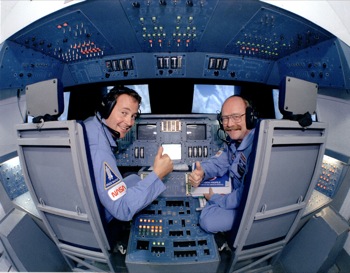
Courtesy Space and Rocket Center
In 1819, 44 delegates gathered in Huntsville to draft a constitution that paved the way for Alabama to become a state; 150 years later, Huntsville played a pivotal role in man’s first steps on the moon. Today, the northern Alabama city honors its rich past while embracing its leading role in modern space exploration.
“You can experience your past, your present and then the future all in Huntsville,” said Pam Williams, tourism sales manager for the Huntsville-Madison County Convention and Visitors Bureau. “The downtown area has the largest collection of antebellum homes in Alabama; we were occupied rather than destroyed during the Civil War. You can experience them with a step-on guide through the Twickenham Historic District, then go all the way to the 21st century at the U.S. Space and Rocket Center.”
As Williams noted, this combination of 19th-century and 21st-century attractions makes for “an exciting twist” for groups visiting Huntsville. The theme of her main suggested itinerary for groups — which can be customized — is “The Antebellum to Antigravity Experience.”
Most tours start in reverse with a “spacenapping” of their motorcoach. CVB staff members carrying laser guns and dressed in space suits and campy “alien” outfits board the bus and take the group to the visitors center for a welcome reception that includes treats such as MoonPies and Milky Ways and a photo opportunity with an astronaut cutout.
Space artifacts
Then it’s on to the Space and Rocket Center, which has one of the most comprehensive collections in the country of artifacts about U.S. manned space flight.
The nearby Marshall Space Flight Center has played a leading role in designing and developing rockets for U.S. space flights since the early 1950s, when German scientist Wernher von Braun arrived. The museum at the Space and Rocket Center has documented those efforts for nearly 40 years.
| Courtesy Courtesy Space and Rocket Center |
It has up to 1,500 artifacts on display at any one time, from large rockets and a full-size space shuttle sitting atop its fuel tanks to gloves worn on the moon by Apollo 11 astronauts. The center’s two-year-old, 476-foot-long Davidson Center for Space Exploration serves as its new main entrance. Its most dramatic artifact is a 36-story Saturn V rocket, much of which is suspended 10 feet above the floor.
“It was built primarily to house the Saturn V,” said Al Whitaker, public relations manager for the space center.
The mammoth Saturn V was used to launch Apollo spacecraft on their way to the moon. The one on display was the test rocket.
“When you hear stories about when the five first-stage engines shattered windows in town, this is the one they fired,” said Whitaker. “It was the only one built here in Huntsville, although all were designed here.”
One of the interactive exhibits at the museum lets visitors experience what the sound and vibration of the rocket was like from a half-mile away.
A new permanent exhibit scheduled to open in the Davidson Center in January will trace the history of Huntsville’s role in the space program.
“When NASA came to town, it completely changed the face of this geographic region,” said Whitaker. “Huntsville at that time was the Watercress Capital of America. It has gone from that to Rocket City.”
Shift in time
After viewing displays about the International Space Station and the future of space exploration, groups can make a dramatic shift in time at Alabama Constitution Village.
“It is where Alabama became a state in 1819,” said Williams. “I like to call it a miniature Williamsburg with reconstructed buildings and live interpreters showing what town life was like then.”
The demonstrations include a blacksmith hammering at his anvil, bread being baked over an open fire and wood being shaped on a large wheel lathe in the cabinetmaker’s shop. The village is part of a complex that also includes the nearby Historic Huntsville Depot.
“The depot was built in 1860,” said Williams. “It was active from the Civil War through the Vietnam War.”
The building was used as a prison and a hospital during the Civil War, and graffiti from soldiers is preserved on second- and third-floor walls.
“Both the village and the depot have evening functions for groups,” said Williams. “They can have Vitals in the Village with some kind of activity plus dinner, while the depot has a couple of options — a hobo dinner or a Phantoms of the Depot program. It is supposedly haunted.”
Groups can get a look at rural life in the 1800s at Burritt on the Mountain, a living-history site with restored 19th-century cabins, a barnyard, animals and interpreters surrounding the eclectic mansion of Dr. William Henry Burritt, a third-generation homeopathic physician who left his estate to the city.
Groups can arrange for a murder mystery dinner at Burritt on the Mountain.
For a shopping stop in the 19th century, groups can visit Harrison Brothers Hardware Shop, the oldest operating hardware store in Alabama, which has been around since 1879 and in its present location since 1897.
The store still has the original floors and high ceilings, tiny numbered drawers lining the walls, rolling ladders, a hand-operated rope elevator and a pot-bellied stove in the winter.
“It is really how the Harrison Brothers left it, including the 100-year-old cash register,” said Charles Winters, vice president of marketing for the CVB.
Half of the store is now a gift shop, where you can purchase items such as cotton throws, marbles by the scoop, cast-iron cookware, oak rocking chairs, garden gadgets, bird feeders and whirly-gigs.
For a more current but still nostalgic shopping stop, groups can hit Huntsville’s Interior Marketplace, located in a 1920s Southern farmhouse and a former country church. The venue has boutique shops, a gourmet cafe and a spa, and groups can arrange for cooking demonstrations and fashion shows.
A contemporary stop is the new Bridge Street Town Center, located in a village-style setting around a 10-acre lake near the space center with mid-priced to upscale shops and a variety of dining, from casual to fine.
“It has an open-air, European feel with gondola rides on the lake,” said Williams.
Festive site
Another lake, the spring-fed Big Spring Lake, is a central feature of downtown’s Big Spring International Park, the site of several annual festivals and musical concerts.
The Huntsville Museum of Art, which is doing a major expansion, is located on a rise overlooking the lake. The museum’s permanent collection focuses on Southern American art, and it presents several traveling exhibitions each year. The World of the Pharaohs is scheduled to be at the museum next fall after a nine-month run at the Arkansas Arts Center in Little Rock.
“It has a nice restaurant on site with indoor and outdoor dining that overlooks the lake,” said Williams. “We have several restaurants attuned to groups.”
The owner of the casual Italian restaurant at the art museum, who earned two Mobil Five-Star awards in California, has another downtown restaurant in a three-story 1821 brick building.
According to Williams, the Main Street Café, which is located in the former city hall and jail in adjoining Madison, Ala., is another restaurant in a historic setting that works well with groups.
“I recently had a group that started its tour with lunch there,” he said.
Dining on contemporary American fare in a 19th-century building seems an appropriate start to a Huntsville visit.
Researching your trip:
Huntsville-Madison County Convention and Visitors Bureau
(800) 843-0468
www.huntsville.org










